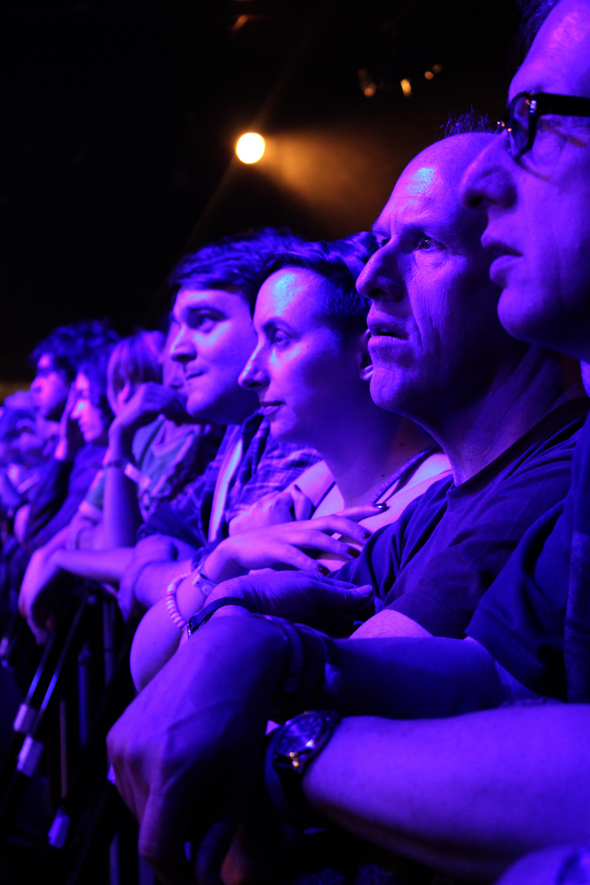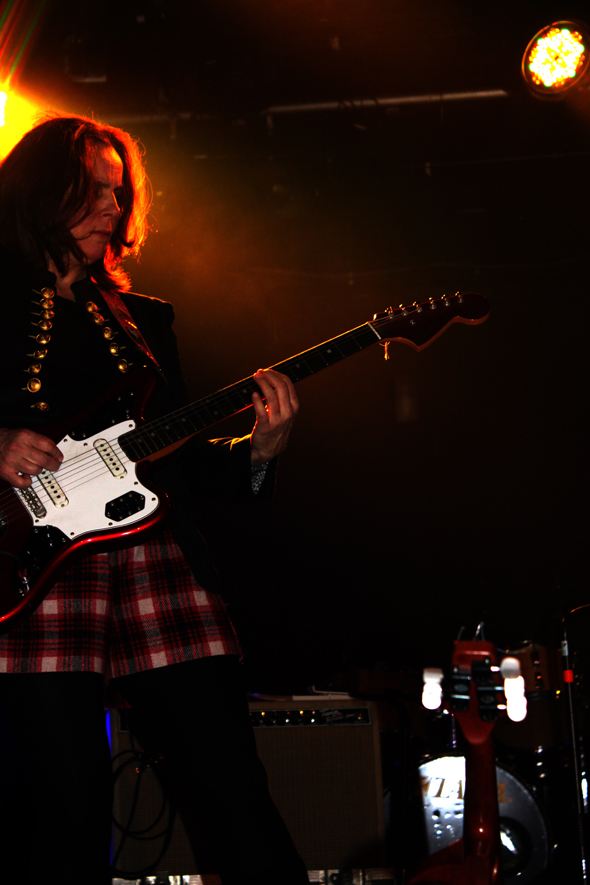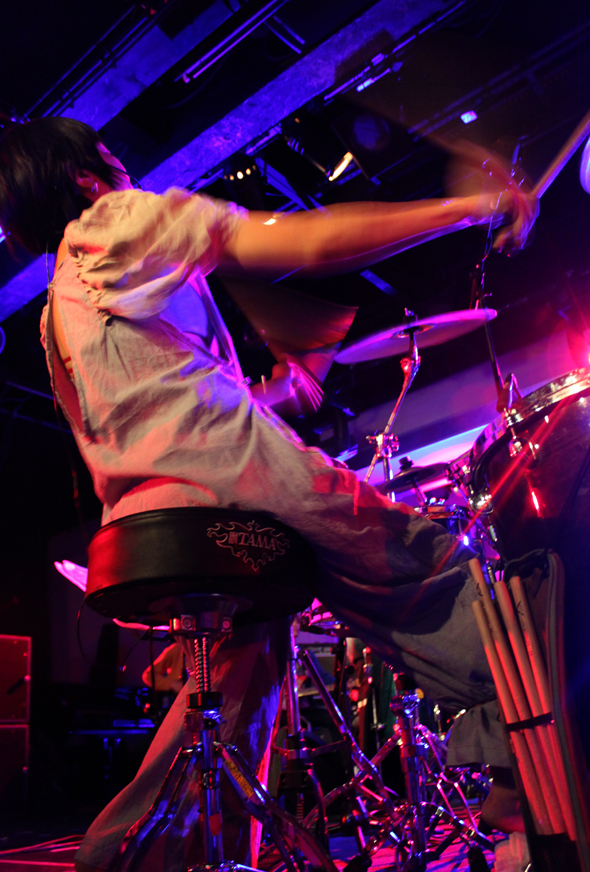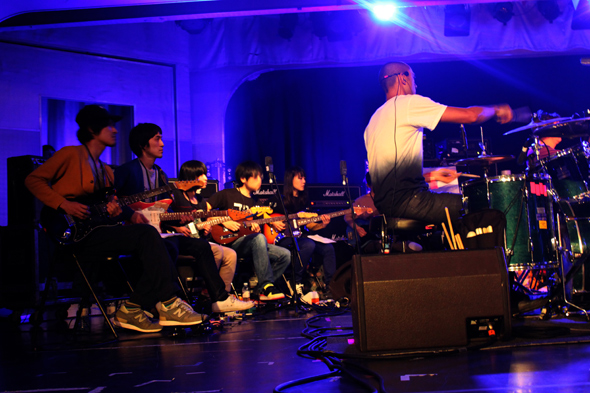Photography: Michele Wade
Yeah, I can see why people hate All Tomorrow’s Parties, the alterno-music festival that’s held in a seaside holiday camp. Or hate the idea of it. Running your eye down a typical line-up makes you wonder what decade we’re in. What century even. Now spreading its cardinganny tentacles across the globe with Parties in Japan, Australia and America, it’s easy to cast ATP’s USP as nostalgia-merchandising for aging indie kids, to scoff at it for allowing a certain brand of music fan whose record collection/mind stopped expanding when they turned pipe’n’slippers at 35 to indulge in “Ah, now this is Proper Music! Kids today, eh?” mutterings while closing their weary ears to the marvels that are being dreamt up now. Is ATP essentially any different to the themed weekenders that this very same Butlins holds throughout the winter months, the Disco Infernos (no, not that one) and the Ultimate Eighties parties? Well, no. It isn’t. You could argue that the line-ups are much more consciously and creatively picked by their guest curators, that ATP’s idea of “alternative” is more strictly accurate than Butlins’ own (whose Great British Alternative Festival features The Beat, The Damned, Hazel O’Connor and, uh, Eddie And The Hot Rods), but you couldn’t really make a case for it being a different order of things. It’s still just a group of 30/40-somethings gathering in a holiday camp to get drunk and watch bands whose heyday was decades ago. Bear with me. I fucking loved ATP.
Running your eye down a typical line-up makes you wonder what decade we’re in. What century even. Now spreading its cardinganny tentacles across the globe with Parties in Japan, Australia and America, it’s easy to cast ATP’s USP as nostalgia-merchandising for aging indie kids, to scoff at it for allowing a certain brand of music fan whose record collection/mind stopped expanding when they turned pipe’n’slippers at 35 to indulge in “Ah, now this is Proper Music! Kids today, eh?” mutterings while closing their weary ears to the marvels that are being dreamt up now. Is ATP essentially any different to the themed weekenders that this very same Butlins holds throughout the winter months, the Disco Infernos (no, not that one) and the Ultimate Eighties parties? Well, no. It isn’t. You could argue that the line-ups are much more consciously and creatively picked by their guest curators, that ATP’s idea of “alternative” is more strictly accurate than Butlins’ own (whose Great British Alternative Festival features The Beat, The Damned, Hazel O’Connor and, uh, Eddie And The Hot Rods), but you couldn’t really make a case for it being a different order of things. It’s still just a group of 30/40-somethings gathering in a holiday camp to get drunk and watch bands whose heyday was decades ago. Bear with me. I fucking loved ATP.
First of all, it’s a festival with beds. Roofs. Kettles. Hot showers and roast dinners. A total dearth of hippies and mud. We roll into Butlins after a long and mostly featureless drive, the last hour in gathering dusk and along the twisty country roads that lead from Taunton to the small beached hummock of a seaside town that is Minehead, to find our misleadingly-named chalet is actually a small third-floor apartment with sofa, table, kitchen, television etc. Oh joy! Cue cooing over the dishwasher and microwave, neither of which we would use over the course of the weekend. Although we do bake cakes and a huge pot of soup from which we replenish ourselves on between-bands chalet trips. (On Saturday I overhead a group of people making enthusiastic plans to cook venison stew and had to stop myself from snorting out loud.)

On the whole it’s a well-dressed and likeable crowd (no hippies, remember; no trustafarian twattishness, no “Uni” students in comedy hats). Everyone I meet from Sheffield is wearing a suit. Everyone from Leeds is absurdly cool. Everyone from Scotland knows everyone else from Scotland and is magnificently drunk. By Sunday afternoon I’ve been introduced to so many youngish/oldish men with beards that I’m smiling at all of them, just in case. There are lots of people here in the same glasses, you know the ones? Everyone over 40 looks like they’re in a seminal indie band. That’s quite an impressive look for oldsters to pull off and, to be fair, most of them probably are in a seminal indie band, given ATP’s remarkable lack of separation between performer and punter. Everyone here’s a geek-level fan. I discover the man in the peculiar hat I’d noticed in audiences throughout the weekend is a key member of Olivia Tremor Control. I see Alison from Young Marble Giants who played on the first day still smiling as she queues to get into the last act on Sunday. Eye from Boredoms down the front for The Raincoats. Mike Scott from The Waterboys (who weren’t playing) agog at Joanna Newsom. Low take a 30-strong crowd jogging along the seafront on Sunday morning. It’s all rather egalitarian and lovely.
Above all, ATP brings you the music its curator loves, the music they want to hear played live even if the band in question split up years ago. It’s all about being head-over-heels in love with music.


Any festival is an interactive adventure game: you make your choices (Turn left? Turn right? This band? That band? Fight troll? Have a lie-down?) at any given point and you plough your own path through its varied offerings, carving out an experience that is unique to you alone. But ATP has always seemed a more collective experience than most. Maybe it’s simply because there are fewer options at any given point in time, fewer bands playing for fewer hours in the day and on only three stages (although that doesn’t take into account the extra-curricular activities available: the swimming, bowling, arcade games, pub grub, pop quizzes, book clubs etc). It’s like when there were only four channels available on TV: you knew that just everyone would’ve watched last night’s episode of Doctor Who and would be talking about it in class the next day. Here everyone’s buzzing with the thrill of Boredoms' performance, chuffed by The Fall delivering the goods, and – gallingly for me, who missed it – enthusing about the intensity and ohmigod specialness of festival curator Jeff Mangum’s solo set. However, even given the communal heterogeneity of the ATP experience (and this one at first glance screams “just gimme indie rock!” for all its little white boy lungs are worth), you can still pick and choose a route to make your festival less dewy-eyed, glory years rerun and more an opportunity to chance upon extraordinary music.
If you wanted to trace a Wire-ish path through the weekend, for example, you could follow the breadcrumb trail of ‘contemporary’ music laid by the avant-genii likes of the Sun Ra Arkestra, Roscoe Mitchell, Group Doueh, Matana Roberts/Seb Roachford, Blanck Mass, Earth, Demlike Stare, even a performance of Gavin Bryars’ ‘Jesus Blood Never Failed Me Yet’ by the American Contemporary Music Ensemble and it would be blindingly clear that my indie-boy slur on Mangum’s sensibility has been skewed by the headliners. You could equally well stick to current women-centred excellence by seeking out the eerie aceness of Canadians Yamatanka//Sonic Titan, all Noh-theatre make-up, fluttering fans and drama; the elemental lyricism of Joanna Newsom; Versus’ proto-Mathy magic; Feathers’ psychedelic dream pop [presumably NOT the psychedelic dream pop of all-female Brisbane band Feathers, though? - Ed]; you could worship at the feet of rock goddesses Mimi from Low, Eleni of The Fall, Boredoms’ Yoshimi P-We and, er ... OK, so the womanly side of ATP isn’t that much in evidence after all: let’s have a female curator next time, eh?
In fact, in the end, by failing to catch Sebadoh or either of Mangum’s sets, my ATP doesn’t much resemble the early 90s wallow-fest the line-up first suggests. I manage to miss Mangum’s first set in a combination of just-got-here high spirits, long queues and disorientation that the main stage - which is usually situated in the middle of a gigantic turreted pavilion, surrounded by bars, Burger King and covetable band merchandise - has been moved upstairs. ‘Centre Stage’ is yer typical Butlins glitter-ball and glass venue which has surprisingly excellent sound and tiers of seats and tables above the dancefloor for those as want. Which, at some point in the whirl of bands and alcohol and more bands and more alcohol, most people do. It turns out that there will be no bands on in the pavilion all weekend, a fact that enrages at first because it means that there will be no wandering in and out at will during the most popular acts, and which inevitably leads to increased queues and schedule-anxiety. But by the end of the weekend it’s clear that the decision was a good one: the sound is much better and the atmosphere more intimate in the Centre Stage space; it would’ve been a shame to lose utterly blusterless acts like Magnetic Fields, Joanna Newsom or even, presumably, Jeff Mangum, in the unenclosed vastness of the pavilion.

I say presumably because my weekend is bookended by a similar defeat at the feet of the interminable queue to see him close the festival: a queue created by the decision to boot every last punter out of the venue before he plays and which results in a line of weary festival-goers waiting to get back into the room they’d just vacated, a queue trailing from the barriers of Centre Stage, all across the pavilion, along past slot machines and the bowling alley, out of the doors the other side, past the security line-up, and straggling off into the night. I walk past it and carry on walking back to the chalet and bed.
The other immediate annoyance is that Friday night’s line-up is both full-on and full of teeth-grinding schedule-clashes. The Raincoats overlapping with The Fall?! Young Marble Giants directly up against Joanna Newsom? Thurston Moore versus Half Japanese? Minutemen main men at the same time as Jon Spencer's Blues Explosion? It’s like some kind of aging hipster bad dream, a test of loyalty and taste set up by a maniacal Cowell-a-like demon to poke the X Factor haters in their most tender of fanboy places. In the end we just have to make our choices, set our hearts against regret and go for it.
By the way, spot the odd one out in that list. Yes, Joanna Newsom is young, female and current. Everyone else, even the two outfits which are still producing new music, The Fall and Thurston Moore, are trading to some extent on past glories, are bands who maybe we’d really rather be TARDIS-ed back to watching in 1978 or 1988. There are even bands who’ve washed up here outside of their time and without their frontmen (Sun Ra Arkestra and The Magic Band: neither of whom I saw but SRA at least seemed to bring the razzle and send folk bouncing out happy after their set).


Not that there aren’t obvious pleasures in seeing bands you missed first time round - I’m glad I’ve seen Young Marble Giants and The Raincoats now - I have context; I have experience– but there is something profoundly peculiar in watching middle-aged musicians play their own music, composed in youth and naïvety and cheerful ineptitude, note-for-note 30-odd years later. That music was played by kids who were radiant with newness, whose youth was firing self-belief and fuck-it-isms at the world, who didn’t care if they couldn’t play 'properly' and were all the more glorious for it; what does it mean when these very same people, with decades of proficiency behind them, are recreating the same songs? And, unlike The Fall, say, aren’t continuing to make new music? Where does the musicianship go? Where is the wisdom and the effect of the passing years? Does it leave no mark? And although it’s undeniably enjoyable to see the songs of your youth played live it tends to be a show, rather than a revelation. It pushes different buttons. It might be unfair to cast Sebadoh, Scratch Acid, The Minutemen, Neutral Milk Hotel, Young Marble Giants or The Raincoats as merely reformed Showaddywaddyesque end-of-pier acts when their shows are so few and so good and so particular to context but it’s also worth remembering that sometimes it’s just fine to have good old-fashioned fun at the seaside.

Young Marble Giants were beautifully low-key, and like The Raincoats, appeared to be enjoying themselves immensely (I’ve written about both of these, The Fall and Joanna Newsom here.) There’s definitely more to be wrung from the experience by those who are here to revisit dearly-loved vinyl than those for whom this is new territory: memories and nostalgia add warm and fuzzy resonance to each chord struck.
The Fall have no time for look-back bores: they plough relentlessly through a set of old and new songs, the gruppe as shiny, fierce and full-on groove monster commanding a mosh pit roiling with sweaty bodies and exhilaration. And I’ve never seen such a high volume of Fall fans in one place: it’s like a lone inheritor of an obscure language suddenly finding themselves amongst a tribe of native speakers, an alterniverse where Mark E Smithisms are the lingua franca. Here, in the voluble intoxicated chatter of the outside smoking area, he is appreciated. Operation mind-fuck, indeed.


Thurston Moore - who from a distance looks exactly the same as a decade ago when I last saw him play, all hair and plaid shirt - seems to be playing material from his solo album of decade ago rather than his acoustic stuff from last year but I like it a lot. Maybe because, unsurprisingly, it makes the same sort of Moebius-twisted shapes as Sonic Youth. Moore is a master of harmonics; he coaxes microtonal dramatics out of top-end heavy blasts of noise, two guitars, a violin (no bass) whipping up a trebly squall. “What’s new?” he says. Yes, well. What is? New isn’t a priority here. Does that matter?
Jon Spencer plays his usual dirty blues – a double dose of old that has end-of-the-evening me thinking of Status Quo, despite or because of his mesmerising shiny leather kecks and the tremendous righteous battering he gives to ancient rock’n’roll tropes. By this point in the day – he comes on at one in the morning – everyone is too fucked to care; we’re down to bloodthumping basics.
Scratch Acid, Saturday’s main stage closer, pass summa cum laude the, er, acid test of whether a band entirely unknown to the listener can engage them; no enhancements, no performance-boosters of nostalgia or familiarity or celebrity or reference points or fondness, just the bare bones of an experience, the playing of the music. I know its illustrious spawn, Jesus Lizard and Rapeman, but I’ve never heard a note of Scratch Acid before and don’t expect much of it. But each successive song has me edging forward, out of my seat and onto the floor until by midset I am mid-mosh where a bare-chested David Yow is being carried aloft on the crowd. Scratch Acid make the kind of furious noisy mess that makes me want to singalong raucously even though I don’t know a single word. It makes me stamp and shout and grin. It makes me rush up to Yow an hour later and gush at him about how brilliant he was (and he seems genuinely touched by my enthusiasm, gives me a hug and wishes me nothing but the best. Agh, starstruck!).
Then, two successive afternoons, out of the Spring sunshine and into the glitterball dancehall, there’s Boredoms. Boredoms turn out to be so transcendentally awesome that their performance alone is justification for the continued existence of ATP and I thank Jeff Mangum from the bottom of my uplifted heart for having the intelligence and savvy to put them on. To put them on twice, even! No one can follow them. Earth suffer particularly in this respect, their trancey drones ample consciousness-altering fodder in the usual course of things, but no match for mass post-Boredoms euphoria. (Review to follow.)
So what’s new? Does it matter that a festival schedules mostly oldies for oldies? I guess not. Music isn’t linear. There’s no “progress” being made, just evolution, revolution, change. What’s the difference in discovering Scratch Acid like a revelatory noise rock thunderbolt from the blue and hearing Pussy Riot for the first time if both make your heart skip a beat? Music is only notes; the listener provides as much context as the era it sprung from. Heart-racing excellence isn’t confined to the new. So party on, ATP. You bring new things to mix, even if they’re decades old. If it were me picking a line-up, I’d ramp up the girl quota and keep the dinosaurs down to no more than a quarter of the acts. But even if you’re reconfirming prejudices and preferences in some of your attendees then I’m going to have to let it go, because in the end you are dealing in love and thrills. And I’m all for that.















